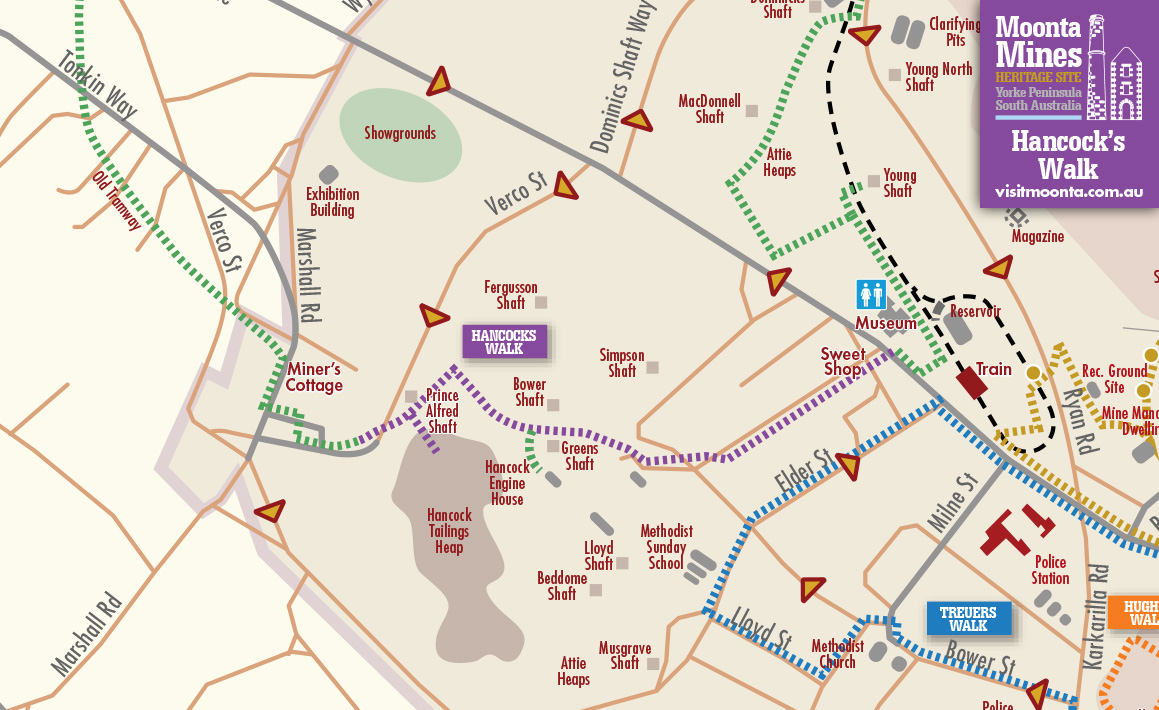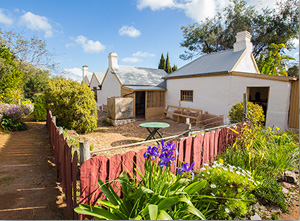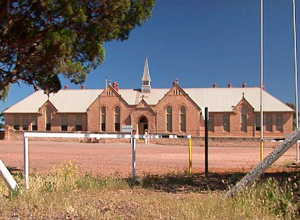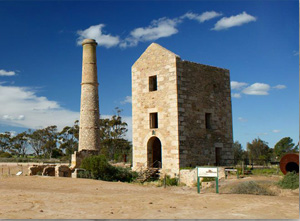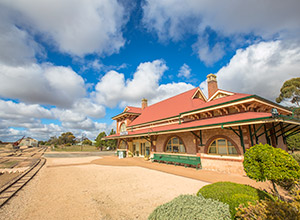Walk 5 – Hancocks Walk
Miner’s Cottage to the Museum, visiting prominent mine shafts, ore stacking floors, mine building ruins. Approx time 1 hour and can be walked in either direction. Please keep to the defined trail marked by signs and arrows.
Miner’s Cottage
The cottage is typical of the type built by the Cornish miners and as the family members increased more rooms were added, hence the hip and valley roofline. The cottage is furnished as a miner’s home about the 1900’s period and has been lived in by brick makers and miners.
Look at information board at start of trail.
Hancocks Tailing (Skimp) Heap
This contains the waste crushings of the ore after concentration by crushing and jigging. The concentrated ore was sent to the Wallaroo Smelters. There were 5 large tailings heaps on the Moonta Mine containing approximately 60,000 tons. There was still some copper in these crushings and in 1900 the cementation process was introduced to leach out the copper and precipitate it.
The terracing of the heaps and pumping of seawater over them is part of the copper recovery process, which is fully explained in the Cementation Work. Take a ride in the National Trust Tourist Train into this area for further explanation.
Prince Alfred Shaft
Situated at the south end of Fergusons Lode is 720 feet (219m) deep. The shaft was worked by a cable from Bowen Winding Engine. In 1872 a magnificent specimen of yellow ore weighing upward of a ton. The mouth of the shaft had to be curt away to enable the specimen to pass through it. It was intended for the Exhibition in Europe.
Ferguson Shaft
Fergusons Shaft 1,224 feet (373m) deep is the deepest in this segment and was wound from Bowed Engine House. The base of the overhead shear legs can be found and likewise in a row towards Bowen Engine House the cement bases for the poles holding the overhead winding cable. In the 1872-1876 period Fergusons and Prince Alfred Shafts were the richest section of the mine.
Fergusons Ore Floors
Fergusons Ore Floors in 1873 there were monster XX of ore including native copper and grey ore of a high percentage of copper and some lumps of malleable copper weighing nearly ½ a hundred weight (56 pounds or 123 kilos).
Pickey Boys sitting at wooden tables would sort the ore. It has been recorded that they had little shelter from the hot summer sun or winter rains, except for a brushwood shelter. In 1878 the average wage for a tribute miner was £($XX) a week.
Note the various gauges of rail beds across the floor. The 2 foot gauge was used to convey the ore to the crushing plant at Hancock Engine House. The 5 feet 3 inch horse drawn wagon system (rail bed approx 10 feet wide), took the concentrated ore from the crusher to the Yelta siding and then to the Wallaroo Smelters. This 5 feet 3 inch gauge was reduced to 3 feet 6 inch in 1891 when locomotives took over the haulage from Moonta Mines to the Wallaroo Smelters.
Bowens Winding Engine House
Bowens Winding Engine House ruins can be identified. Bowens Shaft 432 feet (131m) deep and nearby Simpson Shaft 510 feet (155m) deep are situated on greens Lode. The engine worked shafts on Ferguson Lode and Greens Lode.
Greens Shaft
Greens Shaft 1230 feet (374m) deep. Hancocks Engine worked the pump in this shaft which drained the load and also Beddowes Lode via a 500 feet diamond drill hole at the 200 fathom (1200 feet or 365m) level.
Information Shelter – look at the various photos and plans of this area.
Hancocks Engine House
Hancocks Engine House – there were 3 Cornish boilers here on the east side of the engine house and on the western side were the crusher and jigger house. From this elevated position note how the rail beds lead across to the shaft for hauling the ore up into the crusher. The cutting for drainage is near the jigger house site and was the site of a fatal incident when being supervised by Captain Faull.
There were also XX for concentrating the ore and large settling tanks for the XX which are situated east of Simpsons Shaft.
A separate trail leads southward to Beddomes Shaft 1560 feet (475m) deep and associated engine house and ore floors. Very rich ore was also taken from this shaft. The boilers in this engine house exploded on three occasions.
Return to main trail and information shelter.
Fatal accidents in this section of the mine:
- David Kerr – Aged 28 – January 1868 – Missed footing and fell 10 fathoms (20 metres) at Bowers Shaft.
- John Hodge – Aged 42 – December 1881 – Killed at Beddomes Shaft by the giving way of an end piece which buried him.
- John Dorman – Aged 35 – June 1882 – Lost a leg at Greens Shaft when the skip fell.
- Frederick William Atkinson – Age 28 – March 1884 – Died when the Beddomes boiler exploded.
- James Ebenezer Woolcock – Aged 19 – June 1889 – Killed while digging a drain near Hancocks under Captain Faull.
- George Jose – Aged 42 – July 1890 – Died when the Beddomes boiler exploded.
- John Curran Williams – Aged 58 – July 1891 – Killer in old shaft near Hancocks Engine House.
- Captain Thomas Cornelius – Aged 47 – February 1897 – Died at the 200 fathom level (440 metres) at Beddomes Shaft. He fell 6 fathoms (12 metres) from a ladder when the ground gave way – a popular mine captain. His funeral was ½ mile (3/4 km) long.
- Thomas Thomas – Aged 19 – February 1897 – Killed at Hancocks crusher house when caught in a rope which wound onto a drum.
From the Information Shelter as the walk continues towards the Museum rail beds across the ore floors – special tradesmen were employed laying these floors and building the walls. Drains also be noted for drainage the excess mine waters back to the sea near Moonta.
The Museum situated in the former Moonta Mines Primary School (built 1878) is an interpretive centre for Moonta history and Cornish copper mining period.
